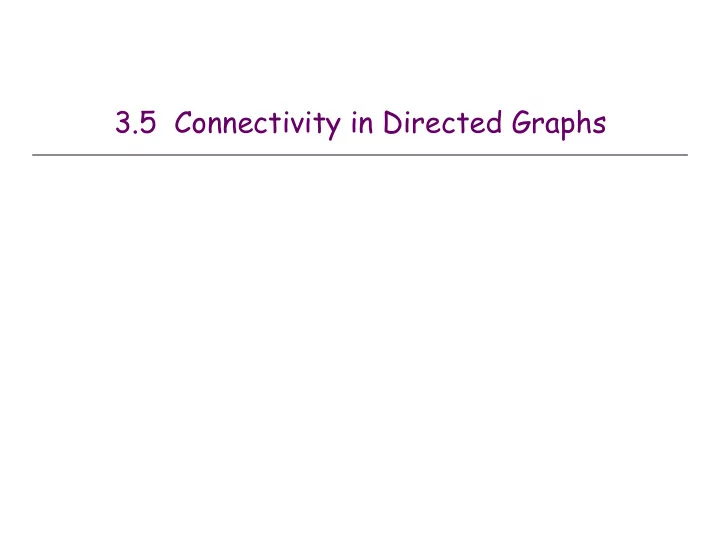

3.5 Connectivity in Directed Graphs
Directed Graphs Directed graph. G = (V, E) Edge (u, v) goes from node u to node v. Ex. Web graph - hyperlink points from one web page to another. Directedness of graph is crucial. Modern web search engines exploit hyperlink structure to rank web pages by importance. 34
Graph Search Directed reachability. Given a node s, find all nodes reachable from s. Directed s-t shortest path problem. Given two node s and t, what is the length of the shortest path between s and t? Graph search. BFS extends naturally to directed graphs. Web crawler. Start from web page s. Find all web pages linked from s, either directly or indirectly. 35
Strong Connectivity Def. Node u and v are mutually reachable if there is a path from u to v and also a path from v to u. Def. A graph is strongly connected if every pair of nodes is mutually reachable. Lemma. Let s be any node. G is strongly connected iff every node is reachable from s, and s is reachable from every node. Pf. ⇒ Follows from definition. Pf. ⇐ Path from u to v: concatenate u-s path with s-v path. Path from v to u: concatenate v-s path with s-u path. ▪ ok if paths overlap s u v 36
Strong Connectivity: Algorithm Theorem. Can determine if G is strongly connected in O(m + n) time. Pf. Pick any node s. Run BFS from s in G. reverse orientation of every edge in G Run BFS from s in G rev . Return true iff all nodes reached in both BFS executions. Correctness follows immediately from previous lemma. ▪ not strongly connected strongly connected 37
3.6 DAGs and Topological Ordering
Directed Acyclic Graphs Def. An DAG is a directed graph that contains no directed cycles. Ex. Precedence constraints: edge (v i , v j ) means v i must precede v j . Def. A topological order of a directed graph G = (V, E) is an ordering of its nodes as v 1 , v 2 , …, v n so that for every edge (v i , v j ) we have i < j. v 2 v 3 v 6 v 5 v 4 v 1 v 2 v 3 v 4 v 5 v 6 v 7 v 7 v 1 a DAG a topological ordering 39
Precedence Constraints Precedence constraints. Edge (v i , v j ) means task v i must occur before v j . Applications. Course prerequisite graph: course v i must be taken before v j . Compilation: module v i must be compiled before v j . Pipeline of computing jobs: output of job v i needed to determine input of job v j . 40
Directed Acyclic Graphs Lemma. If G has a topological order, then G is a DAG. Pf. (by contradiction) Suppose that G has a topological order v 1 , …, v n and that G also has a directed cycle C. Let's see what happens. Let v i be the lowest-indexed node in C, and let v j be the node just before v i ; thus (v j , v i ) is an edge. By our choice of i, we have i < j. On the other hand, since (v j , v i ) is an edge and v 1 , …, v n is a topological order, we must have j < i, a contradiction. ▪ the directed cycle C v 1 v i v j v n the supposed topological order: v 1 , …, v n 41
Directed Acyclic Graphs Lemma. If G has a topological order, then G is a DAG. Q. Does every DAG have a topological ordering? Q. If so, how do we compute one? 42
Directed Acyclic Graphs Lemma. If G is a DAG, then G has a node with no incoming edges. Pf. (by contradiction) Suppose that G is a DAG and every node has at least one incoming edge. Let's see what happens. Pick any node v, and begin following edges backward from v. Since v has at least one incoming edge (u, v) we can walk backward to u. Then, since u has at least one incoming edge (x, u), we can walk backward to x. Repeat until we visit a node, say w, twice. Let C denote the sequence of nodes encountered between successive visits to w. C is a cycle. ▪ w x u v 43
Directed Acyclic Graphs Lemma. If G is a DAG, then G has a topological ordering. Pf. (by induction on n) Base case: true if n = 1. Given DAG on n > 1 nodes, find a node v with no incoming edges. G - { v } is a DAG, since deleting v cannot create cycles. By inductive hypothesis, G - { v } has a topological ordering. Place v first in topological ordering; then append nodes of G - { v } in topological order. This is valid since v has no incoming edges. ▪ DAG v 44
Topological Sorting Algorithm: Running Time Theorem. Algorithm finds a topological order in O(m + n) time. Pf. Maintain the following information: – count[w] = remaining number of incoming edges – S = set of remaining nodes with no incoming edges Initialization: O(m + n) via single scan through graph. Update: to delete v – remove v from S – decrement count[w] for all edges from v to w, and add w to S if c count[w] hits 0 – this is O(1) per edge ▪ 45
Recommend
More recommend